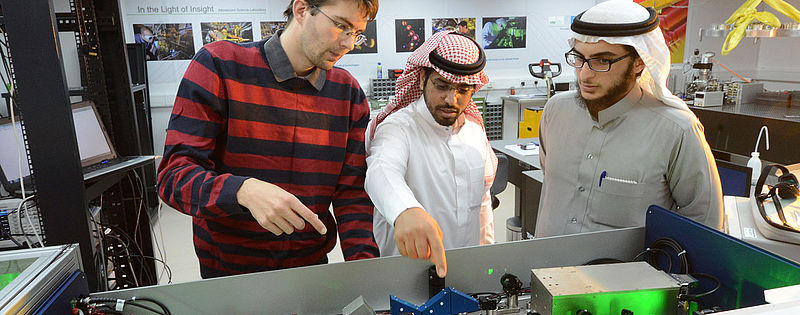featured publications – Electrons cannot hide anymore – even in Saudi Arabia. On February 16th, 2015, the new »Attosecond Science Laboratory« will be inaugurated at the King Saud University in Riyadh. It is the first attosecond laboratory in the whole Arabic world and a product of the collaboration between the Ludwig Maximilians University (LMU) Munich, the Max Planck Institute for Quantum Optics (MPQ) in Garching, and the King Saud University (KSU) in Riyadh. Researchers from the three institutions will use the new facility to investigate electrons in motion.
Electrons, once excited, move in atomic systems within attoseconds. One attosecond is merely a billionth of a billionth of a second (10-18 seconds). To take freeze-frame snapshots of such fast movements, the exposure time must be correspondingly brief. Ultrashort-pulse lasers can produce attosecond flashes of extreme ultraviolet light, which can implement this exposure time. These flashes can »freeze« the motion of electrons on the attosecond time scale, in a similar way to how high-speed cameras are able to capture rapidly moving macroscopic objects with a fast shutter speed.
Since 2001, scientists have been able to generate and measure attosecond light flashes through novel, ultrafast laser techniques and use them to gain insight into previously immeasurable, fast phenomena of the microcosm. Several years ago, researchers from the Laboratory for Attosecond Physics at the MPQ and the LMU teamed up with laser physicists from the Department of Physics & Astronomy Department at KSU in order to proliferate this powerful technology to one of the largest universities in the Arab world. As a result of their efforts and after years of preparation, the Attosecond Science Laboratory (ASL) was created at the KSU. The new laboratory allows the collaboration to perform world-class experiments in Riyadh and provide students from the region access to cutting-edge research in laser science.
Ferenc Krausz, Director at the MPQ and chair holder at the LMU believes that »by creating the ASL, our collaboration can not only spawn new scientific findings – as is normal for every well- performing cooperation – but settles a new field of research like attosecond physics in a region where students have to travel thousands of miles to be able to access this technology.« In addition to the more than 30 research facilities in Europe, North America, and the Far East involved in research into electrons, we now have the first laboratory of this kind in the Gulf States. It offers scientists and students from the Gulf region unique research opportunities at a world-class laser facility.
Motions of electrons are the essential processes of life. For the very first time, with the tools and techniques of attosecond technology we are gaining insight into how they work. In medicine, this new knowledge can help to develop innovative technology for the diagnosis and therapy of incurable diseases. In information technology, attosecond science can provide us with the possibility to quicken signal processing to its ultimate limit, which is believed to be the extreme frequency of light oscillations.
The Inauguration Ceremony will take place February 16th, 2015 at the King Saud University in Riyadh. There world renowned pioneers of laser science, such as Prof. Gérard Mourou, Prof. Paul Corkum, and Nobel laureate Prof. Theodor Hänsch will deliver lectures about their groundbreaking work.
